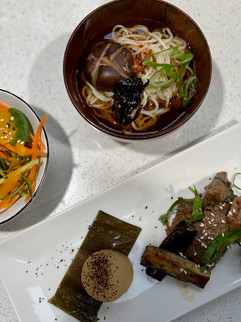japanese delectables
- FH

- Jun 11, 2022
- 2 min read
few of my recent Japanese dishes -- chawanmushi with parmesan foam; chicken sausage with tonkatsu sauce; seared tuna with mango salsa; spicy crab over avocado moouse; kani salad, apple slaw; togarashi smoked salmon; spicy Kobe beef with eggplant and pickled daikon radish...
"Japanese cuisine encompasses the regional and traditional foods of Japan, which have developed through centuries of political, economic, and social changes. The traditional cuisine of Japan (Japanese: washoku) is based on rice with miso soup and other dishes; there is an emphasis on seasonal ingredients. Side dishes often consist of fish, pickled vegetables, and vegetables cooked in broth. Seafood is common, often grilled, but also served raw as sashimi or in sushi. Seafood and vegetables are also deep-fried in a light batter, as tempura.
Apart from rice, a staple includes noodles, such as soba and udon. Japan also has many simmered dishes, such as fish products in broth called oden, or beef in sukiyaki and nikujaga.
Historically influenced by Chinese cuisine, Japanese cuisine has also opened up to influence from Western cuisines in the modern era. Dishes inspired by foreign food—in particular Chinese food—like ramen and gyōza, as well as foods like spaghetti, curry, and hamburgers, have been adapted to Japanese tastes and ingredients. Some regional dishes have also become familiar throughout Japan, including the taco rice staple of Okinawan cuisine that has itself been influenced by American and Mexican culinary traditions. Traditionally, the Japanese shunned meat as a result of adherence to Buddhism, but with the modernization of Japan in the 1880s, meat-based dishes such as tonkatsu and yakiniku have become common. Since this time, Japanese cuisine, particularly sushi and ramen, has become popular globally.
In 2011, Japan overtook France to become the country with the most 3-starred Michelin restaurants; as of 2018, the capital of Tokyo has maintained the title of the city with the most 3-starred restaurants in the world. In 2013, Japanese cuisine was added to the UNESCO Intangible Heritage List." -- Japanese cuisine - Wikipedia
behind the scene
chawanmushi with parmesan foam...
Chawanmushi (茶碗蒸し) is a Japanese steamed egg custard that consists of ginkgo nuts, shiitake mushrooms, kamaboko (Japanese fish cake), and an egg mixture flavored with dashi, soy sauce, and mirin. The egg custard is often served as a cold or hot appetizer. Chawan(tea cup) mushi(steam) literally means teacup steamed egg custard. -- Just One Cook Book
"Foams are one of the techniques most associated with modernist cooking. They are easy to make, very versatile, and fun to use and eat. Foams have been around traditional cooking for a very long time and include whipped cream, head on beers, and even bread dough." -- How to Make Modernist Foams
see my other post -- kaiseki (懐石): my journey through rural japan
spicy Kobe beef with eggplant and pickled daikon radish...
"American Kobe beef - True Kobe beef comes from the region surrounding the city of Kobe. For centuries, the cattle was used not for meat, but to provide the muscle for rice cultivation. Consumption didn't really take off until after World War II. The American version of Kobe beef comes from the same breed of cattle raised in Japan." -- American Kobe-style beef replaces the real thing - NBC News
see my other post -- kobe beef au poivre








































Comments